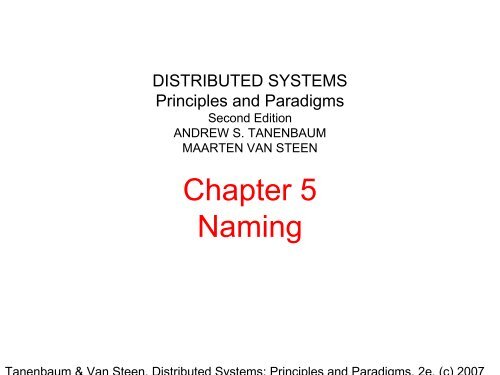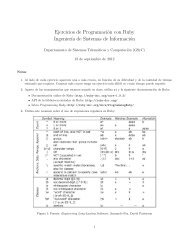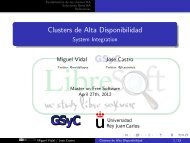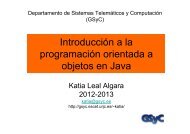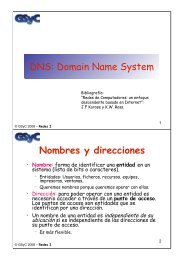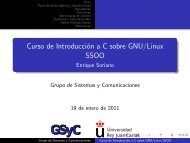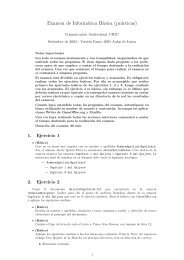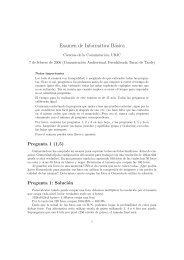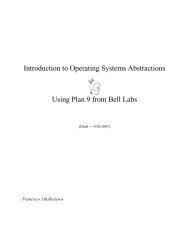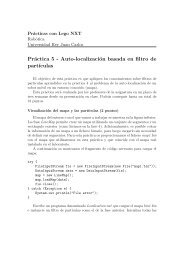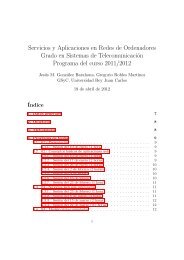Chapter 5 Naming - docencia de la ETSIT-URJC
Chapter 5 Naming - docencia de la ETSIT-URJC
Chapter 5 Naming - docencia de la ETSIT-URJC
Create successful ePaper yourself
Turn your PDF publications into a flip-book with our unique Google optimized e-Paper software.
DISTRIBUTED SYSTEMSPrinciples and ParadigmsSecond EditionANDREW S. TANENBAUMMAARTEN VAN STEEN<strong>Chapter</strong> 5<strong>Naming</strong>
Names, I<strong>de</strong>ntifiers, And AddressesProperties of a true i<strong>de</strong>ntifier:• An i<strong>de</strong>ntifier refers to at most one entity.• Each entity is referred to by at most onei<strong>de</strong>ntifier.• An i<strong>de</strong>ntifier always refers to the sameentity
Forwarding Pointers (1)Figure 5-1. The principle of forwarding pointersusing (client stub, server stub) pairs.
Forwarding Pointers (2)Figure 5-2. Redirecting a forwarding pointer bystoring a shortcut in a client stub.
Forwarding Pointers (3)Figure 5-2. Redirecting a forwarding pointer bystoring a shortcut in a client stub.
Home-Based ApproachesFigure 5-3. The principle of Mobile IP.
Figure 5-4.Resolving key26 from no<strong>de</strong> 1and key 12 fromno<strong>de</strong> 28 in aChord system.Distributed Hash TablesGeneral Mechanism
Hierarchical Approaches (1)Figure 5-5. Hierarchical organization of a location service intodomains, each having an associated directory no<strong>de</strong>.
Hierarchical Approaches (2)Figure 5-6. An example of storing information of an entityhaving two addresses in different leaf domains.
Hierarchical Approaches (3)Figure 5-7. Looking up a location in a hierarchicallyorganized location service.
Hierarchical Approaches (4)Figure 5-8. (a) An insert request is forwar<strong>de</strong>d to thefirst no<strong>de</strong> that knows about entity E.
Hierarchical Approaches (5)Figure 5-8. (b) A chain of forwarding pointersto the leaf no<strong>de</strong> is created.
Name Spaces (1)Figure 5-9. A general naming graph with a single root no<strong>de</strong>.
Name Spaces (2)Figure 5-10. The general organization of the UNIX file systemimplementation on a logical disk of contiguous disk blocks.
Linking and Mounting (1)Figure 5-11. The concept of a symbolic linkexp<strong>la</strong>ined in a naming graph.
Linking and Mounting (2)Information required to mount a foreignname space in a distributed system• The name of an access protocol.• The name of the server.• The name of the mounting point in theforeign name space.
Linking and Mounting (3)Figure 5-12. Mounting remote name spacesthrough a specific access protocol.
Name Space Distribution (1)Figure 5-13. An example partitioning of the DNS name space,including Internet-accessible files, into three <strong>la</strong>yers.
Name Space Distribution (2)Figure 5-14. A comparison between name servers for implementing no<strong>de</strong>s from a <strong>la</strong>rgescalename space partitioned into a global <strong>la</strong>yer, an administrational<strong>la</strong>yer, and a managerial <strong>la</strong>yer.
Implementation of Name Resolution (1)Figure 5-15. The principle of iterative name resolution.
Implementation of Name Resolution (2)Figure 5-16. The principle of recursive name resolution.
Implementation of Name Resolution (3)Figure 5-17. Recursive name resolution of . Nameservers cache intermediate results for subsequent lookups.
Example: The Domain Name SystemFigure 5-18. The comparison between recursive and iterativename resolution with respect to communication costs.
The DNS Name SpaceFigure 5-19. The most important types of resource recordsforming the contents of no<strong>de</strong>s in the DNS name space.
DNS Implementation (1)Figure 5-20. An excerpt from the DNSdatabase for the zone cs.vu.nl.
DNS Implementation (2)Figure 5-20. An excerpt from the DNSdatabase for the zone cs.vu.nl.
DNS Implementation (3)Figure 5-21. Part of the <strong>de</strong>scription for the vu.nldomain which contains the cs.vu.nl domain.
Hierarchical Implementations: LDAP (1)Figure 5-22. A simple example of an LDAPdirectory entry using LDAP naming conventions.
Hierarchical Implementations: LDAP (2)Figure 5-23. (a) Part of a directory information tree.
Hierarchical Implementations: LDAP (3)Figure 5-23. (b) Two directory entrieshaving Host_Name as RDN.
Mapping to Distributed Hash Tables (1)Figure 5-24. (a) A general <strong>de</strong>scription of a resource.(b) Its representation as an AVTree.
Mapping to Distributed Hash Tables (2)Figure 5-25. (a) The resource <strong>de</strong>scription of a query.(b) Its representation as an AVTree.
Semantic Over<strong>la</strong>y NetworksFigure 5-26. Maintaining a semantic over<strong>la</strong>y through gossiping.


